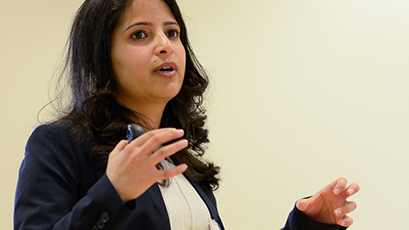- Accessibility Options:
- Skip to Content
- Skip to Search
- Skip to footer
- Office of Disability Services
- Request Assistance
- 305-284-2374
- Display:
- Default
- High Contrast
- Accessibility Options:
- Skip to Content
- Skip to Search
- Skip to footer
- Office of Disability Services
- Request Assistance
- 305-284-2374
- Display:
- Default
- High Contrast
- Apply
- About UM
- Give to UM
-
Schools
- School of Architecture
- College of Arts and Sciences
- Miami Herbert Business School
- School of Communication
- School of Education and Human Development
- College of Engineering
- School of Law
- Rosenstiel School of Marine, Atmospheric, and Earth Science
- Miller School of Medicine
- Frost School of Music
- School of Nursing and Health Studies
- The Graduate School
- Division of Continuing and International Education
- Alumni
School Works to Address Underrepresentation of Women in Finance

By UM News
“So, how do women approach that: Do they try to publish under a false name?” Henrik Cronqvist, professor of finance and director of the School’s PhD program, recalls Hatamyer asking.
Cronqvist mulled the question then approached Renee B. Adams, a noted finance professor at the University of New South Wales in Australia who long has advocated for women in finance. Adams co-founded AFFECT, the American Finance Association’s “Academic Female Finance Committee” in 2015. AFFECT agreed to co-sponsor the conference with the School to tackle the issue. Hatamyer and other PhD students helped organize the event. Bucking the norm, six of out of the School’s 10 PhD students in finance are women.
Adams laid out the gender issue in terms both personal and statistical. When she took her job 10 years ago, she said she was the first female finance professor in Australia. Worldwide, women hold roughly 20 percent of finance jobs, more on the lower than senior levels, she estimated.
Part of the problem stems from the “math gap:” Women tend to underperform in math compared to men. But math alone can’t explain it. Other math-related fields are adding females faster, she said.
Some people blame women, claiming they’re too risk averse for finance. Yet Adams offered three data sets – from the Certified Financial Analyst Institute, academics in Australia and doctoral students in Europe - that all show women in finance to be more achievement-oriented, less traditional and less conformist than their male counterparts in finance, debunking that claim.
Meanwhile, women faculty in finance earn less than men at all levels, said Adams, citing work with the Finance Research Network in Australia and similar studies at U.S. universities. Men also hold more high-level positions, possibly because they can network more outside class while women perform more service work at universities and also handle greater responsibilities at home, she added.
“The evidence suggests women may face different challenges than men in finance,” said Adams, noting women are often compared equally to men for promotions without consideration of time-off for maternity leave. “I think what we should do is change the narrative that it’s the women’s fault.”
“I think it’s important to have more women in the field as they really do act as role models,” said Vidhi Chhoachharia, one of two women on the School’s finance faculty. “Having women finance professors might encourage women to think of finance as a career either as an academic or otherwise.”
The conference provided young upcoming female academics with the opportunity to interact both socially and academically with successful senior female finance professors. They were also able to showcase their research and get comments to help with getting their work published and ultimately earn tenure.
AFFECT offers a set of best practices on its website to boost women in finance, including mentoring, workshops on gender bias and “blind auditions” where the gender of applicants is hidden. For more information, visit www.affectfinance.org.
UM Network
Tools and Resources
Visit
Get social with Miami Herbert
Copyright: 2025 University of Miami. All Rights Reserved.
Emergency Information
Privacy Statement & Legal Notices
Title IX & Gender Equity
Website Feedback
Individuals with disabilities who experience any technology-based barriers accessing University websites can submit details to our online form.
